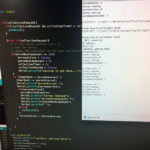Resources:
Overview: This week, I wanted to do a project that focused on parsing data out of an API and doing something with it. I decided weather would be the Path Of Least Resistance due to the fact that everyone has a weather project out there somewhere, and the documentation for weather APIs is pretty solid. I also wanted to explore some of Adafruit’s Feather Wings.
System: For this project I wanted to stay away from BaaS providers. You can do a version of this mashing up IFFTT and Adafruit/IO or the like, but I wanted to instead combine all my parsing / data grabbing / behaviour into one board. The Feather is just an ESP2866 on a breakout. Which means it has the ability to do TCP calls, UDP, act as a wee little web server, or just be a gateway. You can drill down into the functionality using various libraries that are compatible with Arduino. For this set up I decided to parse some JSON directly from the Weather Underground API. The servos themselves run on a repeating timer, for a set amount of time. So they are not on constantly. After which they stop, the feather hits a delay mode for a while until grabbing the next weather conditions and triggering the routine all over again.
Components: Adafruit Feather Huzzah, PWM Servo FeatherWing, 5v 2a Power Supply, 5V power supply (USB port, but could be a plug in), 7 micro servos
Things I Experimented With: Parsing, Libraries, Mapping, Timing, APIs
Things I learned: There’s some library conflicts with the ESP8266WiFi and Wire.h, in so far that you need to declare the PWM before you start doing any pin setting logic. It could be a timer issue (but the PWM board apparently has its own timer), or it could be a bit of a pin mash. I should have been using a 5v 10a power supply, but I didn’t, so that might have also contributed to some funny behaviour. I also need some extra barrel jack adaptors in various sizes.
Of Note: You need little delays for the ESP2866 to be able to process JSON. If you don’t have them, it can sometimes just not grab things.
Future Iterations: The sounds servos make is pretty nice/annoying. I think working more with the timing and figuring out how to make something like this more of an audio piece might be fun. Working more on system timing and run time.















